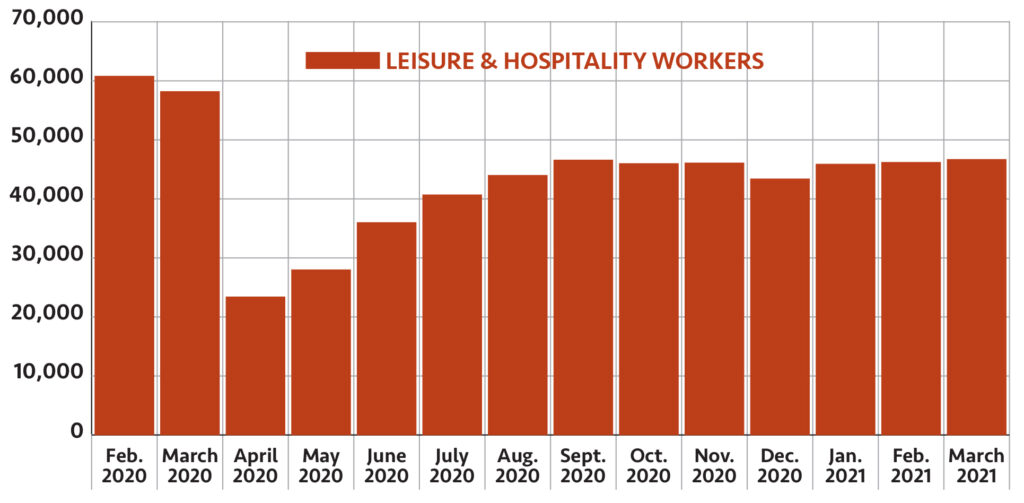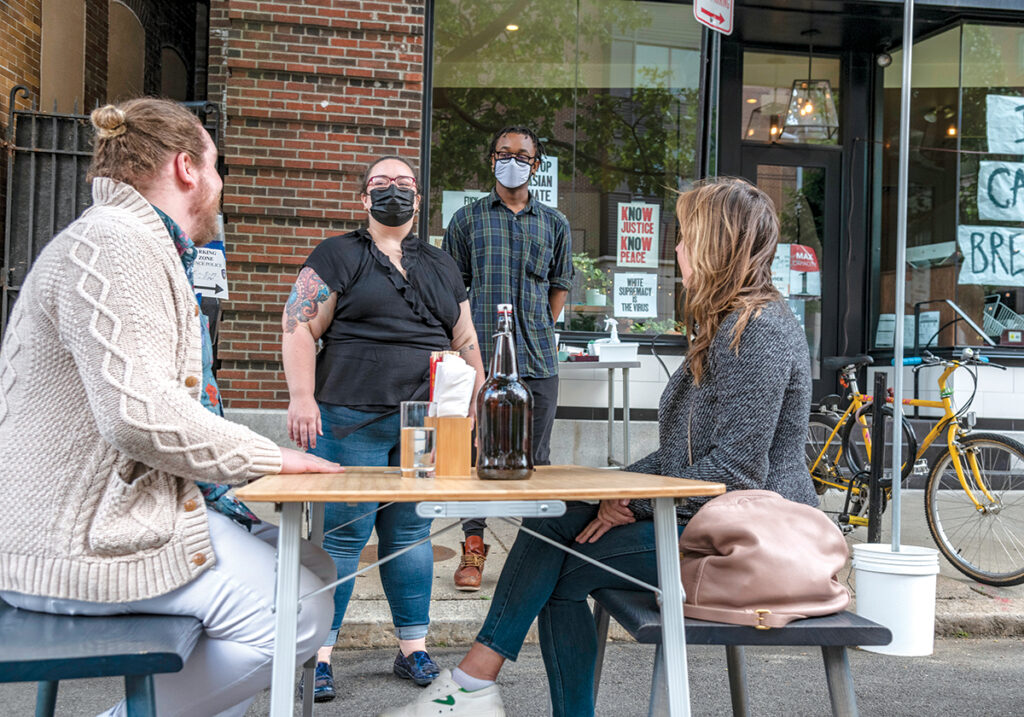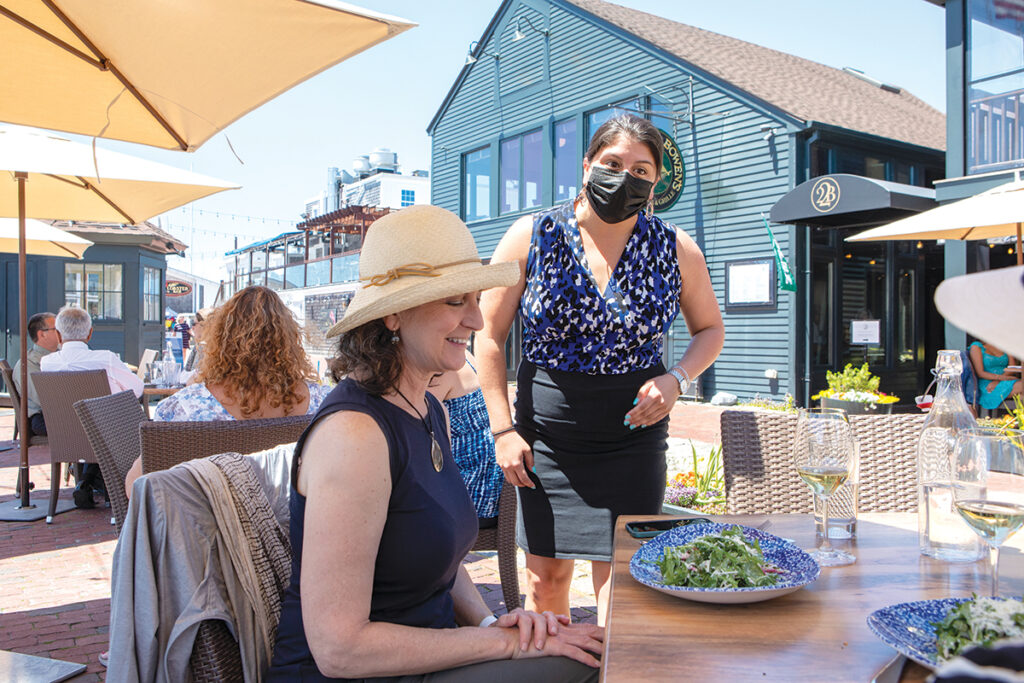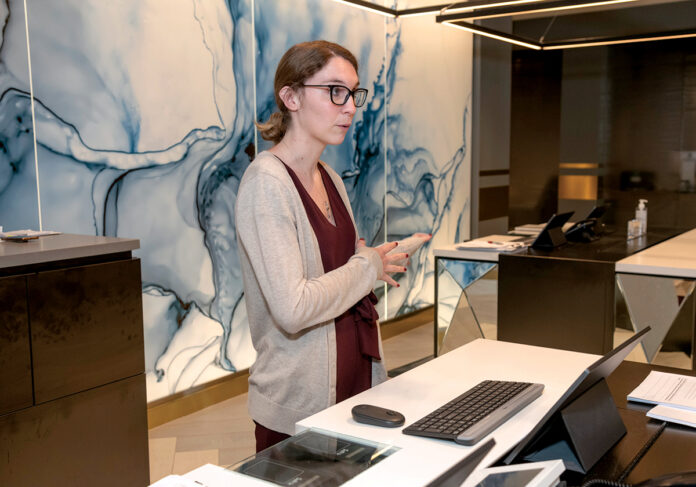Erin Umbdenstock spent her four-month stint of unemployment trying to keep busy.
She cooked and cleaned her Coventry apartment and took up several new hobbies. But she did not look for a new job, because she was holding out to return to work at the Providence Marriott Downtown.
So when her boss, hotel general manager Farouk Rajab, offered her a chance to come back, she didn’t hesitate. She worked the front desk, she did laundry, whatever was needed. Her part-time hours were just enough to take her off unemployment benefits but was still a pay cut and a demotion from her former role as a sales coordinator.
“It’s not what I pictured myself doing,” the 27-year-old Johnson & Wales University graduate said. “But I never thought it was below me or a waste of my time or that I was not using my degree.”
And it paid off. In February, Umbdenstock was promoted to rooms manager, an opportunity she credited in part to the topsy-turvy world created by COVID-19.
But many other hospitality workers have not stuck with the local industry through the pandemic and it’s taking an economic toll, though the shrinking workforce actually predates the virus’s emergence last year. And there’s little agreement, it seems, on the way forward beyond getting through the summer.
SHRINKING WORKFORCE
Data from the R.I. Department of Labor and Training shows that from 2011 to 2019, the leisure and hospitality industry lost 5% of its workforce, while the total state labor force saw no net change. Meanwhile, competition to find workers grew fiercer as the number of food and accommodation employers increased by 11%.
“We didn’t need a pandemic to demonstrate that the worker pool is shrinking,” said Michael J. Sabitoni, department chair for food and beverage management and international travel and tourism studies at JWU. “We have a major image and reputation problem in the hospitality industry.”
While the local industry’s challenges didn’t start with the pandemic, they’ve clearly been exacerbated by it.
In the first month of the pandemic, between March and April of 2020, the leisure and hospitality industry saw seasonally adjusted employment slashed by 60%. By comparison, overall state employment dropped just over 20% in that same period.
Even now, as restaurants and bars have reopened to full capacity and hotels welcome post-pandemic guests, industry employment remains below pre-pandemic levels.
As of March, the most recent month for which data is available, the state had regained about 59% of the 108,000 total jobs lost during the pandemic. However, across the leisure and hospitality sector, jobs were still down 22.6%.
Workers in the hospitality industry also accounted for the highest percentage of unemployment benefit recipients – 21.8% of the 31,500 unemployment claims as of April 17. This does not include pandemic unemployment assistance, for which industry-specific data was not available. Some employers and business groups believe more-generous-than-usual unemployment benefits have made it hard to find workers.
Others, including some economists, blame low wages, long hours and inflexible, stressful work conditions that existed before the pandemic. Add in the fear of contracting a deadly virus or trying to coax an enraged customer to mask up, they say, and the job becomes even less appealing for some people.
The state, for its part, ahead of the crucial summer tourism season moved to amend unemployment policies, reinstating work-search requirements and increasing the part-time earnings recipients can make, while still qualifying for some state and federal aid, to encourage people to work at least some hours. The changes were backed by many state lawmakers, employers and industry groups.
“Part-time work, while not an answer to long-term labor struggles, is crucial to the hospitality industry, particularly as it heads into the summer tourism season,” said Sarah Bratko, lobbyist for the Rhode Island Hospitality Association. She says industry employers are reporting an uptick in people returning to work since the changes took place.
“It’s not to say it has completely solved the workforce shortage, but it’s absolutely helped,” Bratko said.
Rhode Island is hardly alone in trying to revive a battered hospitality industry.
Analysis by the U.S. Travel Association published in February found that nearly 40% of jobs lost over the prior year were in leisure and hospitality. And the National Restaurant Association says the food and beverage industry lost 2.5 million jobs and $240 billion in sales in 2020.
But in a state known for its fine dining and summer seaside destinations – contributing $300 million in sales taxes alone in 2019 – Rhode Island’s economic recovery is more directly tied to its hospitality industry than many other states.
[caption id="attachment_374719" align="aligncenter" width="1024"]

LESS THAN FULL RECOVERY Employment in Rhode Island’s leisure and hospitality sector topped 60,000 jobs before the coronavirus crisis. It then sank to 23,400 in the first month of the pandemic. About a year later, employment levels in the sector remained more than 23% lower than pre-pandemic levels. / PBN GRAPHIC/ANNE EWING | SOURCE: R.I. Department of Labor and Training[/caption]
OVERHAUL NEEDED?
How to reinvigorate the sector’s workforce is unclear. As is the question of who – state government, industry associations or employers themselves – should lead the charge.
“The challenge is that we don’t know what the industry is going to look like post-COVID,” said Bratko. “We can’t take a short-term crisis and try to extrapolate what that looks like long term.”
The hospitality association is focused on helping its 4,000-member businesses recover through employee training, a newly launched job board and advocacy with state lawmakers. But others say that’s not enough, that the industry needs a top-to-bottom overhaul.
“In my opinion, the restaurant industry for nearly its entire existence has built itself upon exploitation in one form or another … the workforce, the farm workers, animal resources, overfishing, you name it,” said James Mark, a James Beard-nominated chef who owns two Providence restaurants, north and big king.
On social media, Mark had harsh words for fellow restaurateurs who bemoaned hiring woes.
“Maybe if you didn’t kick everyone to the curb and try to keep half a dozen restaurants open you wouldn’t have this problem,” he wrote in a tweet in late May. “You didn’t take care of them and it’s reaping season, babe.”
Casey Riley, chief operating officer for Newport Restaurant Group, called Mark’s tweet “terribly judgmental,” adding that he believed it missed the cause of the workforce problem.
“This isn’t about people that left you because you were unfair to them,” Riley said. “It’s about [the] increasing demand that we are just not able to keep up with staffing-wise.”
Mark is unconventional, in his experimental menus and his business mentality. His restaurants offered only takeout throughout the pandemic. Mark refused to reopen until all his employees who wanted a vaccine had gotten one.
He also recently upped the starting pay for front-of-house staff to $15 an hour, mirroring what cooks and back-of-house workers already made, and he instituted a model in which tips are split across the entire staff.
These policies drew Makayla Habershaw to north, where she started as a server in April. Habershaw is not new to the industry; she’s worked on and off, mostly part time as a server, since she was a teen.
But it was in August 2019 that she realized she wanted to make restaurant work a full-time career. She had a 9-to-5 job as a graphic designer and missed the evening hours, the customer interactions and the sense of teamwork.
“I don’t want to just feel like a cog in the wheel,” she said.
Mark, for his part, is determined to make his employees feel cared for – through wages, training and flexibility in things such as bringing their children to work before dinner service starts, if needed.
But there are consequences.
To make the numbers work, he raised menu prices, something he feels conflicted about.
“As craftspeople, we are trying to produce a culture that we want to give to as many people as possible,” he said. “If you raise prices, who are you keeping out?”
It also intensifies the competition. Increasing prices could just send customers to restaurants that have not raised costs and continue to pay their workers less.
Mark envisions an industry where a higher minimum wage and universal health care level the playing field, where workers can live on restaurant wages and support their families, can even eat at the fine-dining restaurants where they work. Right now, most of them cannot.
[caption id="attachment_374717" align="aligncenter" width="1024"]

READY AND WAITING: Servers Makayla Habershaw, standing left, and Ahmed Sesay take the food orders of Jeffrey Bibeau, sitting left, of Providence and Riley Farrar of Washington, D.C., at a sidewalk table at north on Fountain Street in Providence. / PBN PHOTO/MICHAEL SALERNO[/caption]
CULINARY CALCULUS
JWU is working to promote a wider range of possible careers from its food and hospitality degrees.
“If we stick to the way we have always marketed traditional food programs as a path to one specific career, we’re going to be in trouble, no question,” said Jason Evans, dean of JWU’s College of Food Innovation & Technology.
Traditional culinary programs remain crucial offerings, but the university is also highlighting degrees such as culinary nutrition, culinary science and sustainable food systems, which can translate to sports-nutrition work, food safety, product testing and entrepreneurial ventures.
Of course, this does not solve the shortage of workers in more-traditional chef, server and hotelier jobs. But a four-year degree program may not be the best place to supply those workers.
Even as a JWU graduate, Mark looks more for experience than academic credentials when hiring.
“The skills necessary for this industry require reps,” he said, referring to repeated work shifts. “It’s not strictly what you learn in class.”
Evans also said that for those envisioning a career at a restaurant, the starting pay makes it hard to justify four years of a $35,000 annual tuition.
“The calculus they do in their head works against culinary school,” he said.
In response, JWU is preparing to offer by next fall a host of shorter, less-expensive certification programs, Evans said. While he sees the university as a partner in helping supply the industry with workers, some responsibility also falls to employers to adapt.
“Either we’re going to see a very different wage and work structure or we’re going to see a restaurant and hospitality industry that is much less labor-reliant, with smaller menus, more delivery and pickup service, that kind of thing,” he said.
Alan Krinsky, a senior fiscal policy analyst with The Economic Progress Institute, offered a similar “tough love” outlook.
“There will have to be increases in wages and provision of benefits that match what people can find in other areas of the economy,” he said.
Accommodation and food-service workers in Rhode Island continue to sit at the bottom of the list of annual wages, making an average of $23,556 as of March 2020. The statewide average was $60,471.
Recently approved legislation to hike the state’s hourly minimum wage to $15 by 2025 will help, though it does not apply to tipped workers. Other changes that Krinksy said could shift the tide could be mandatory employer-provided health insurance and child care programs.
[caption id="attachment_374716" align="aligncenter" width="1024"]

STICKING WITH IT: Victoria Trujillo, standing, checks on diners at 22 Bowen’s Wine Bar & Grille. Trujillo returned to her managerial job at the Newport restaurant after a two-month layoff in 2020 despite fears about contracting COVID-19. / PBN PHOTO/KATE WHITNEY LUCEY[/caption]
‘MORE DEMOCRATIC’
Some employers are at least considering improved benefits for workers.
The Providence Marriott Downtown, for example, recently surveyed its employees to gauge interest in an on-site day care program. Only a few people seemed interested, Rajab said.
The hotel has also prided itself on being at the forefront of wage increases. While pay ranges differ by department, most new employees start at $13 to $15 an hour, he said.
Rajab painted the hotel industry as one in which advancement and financial success are very attainable. His own career is evidence of that.
A Jordan native who moved to the U.S. as a recent college graduate in 1992, he took a part-time job at a hotel, earning $7 an hour, while looking to start a finance career.
Instead, he fell in love with hospitality, which reflected his native country’s welcoming nature, and worked his way up over three decades. Now he earns more than what he could make in many other industries, he said.
“The problem is people want things fast,” he said. “But if you put the time in, show up, give it your all … there’s opportunity.”
Kristen Adamo, CEO and president of the Providence Warwick Convention & Visitors Bureau, echoed his convictions.
“If anything, hospitality is a more democratic career where you can truly work your way up even if you don’t have a college degree,” she said.
Adamo was also not convinced it was up to employers to make jobs more attractive.
“Their margins are already so narrow; it’s going to be really hard to do something like child care, especially this year when you’re just trying to make up your losses,” she said.
Adamo instead wanted some of the state’s federal stimulus money to go to training and relief for restaurant and hospitality companies.
Matthew Weldon, DLT director, said that nothing definitive has been planned to expand training for the industry. Instead, he pointed to ongoing efforts through the Real Jobs Rhode Island program and the hospitality association.
State programs center too much on higher-level, higher-paying jobs for big companies, says Riley, from Newport Restaurant Group, which has more than half a dozen restaurants and 700 employees. “The entry-level jobs don’t seem to get enough attention,” he said.
His company has the resources to train and pay its workers better. It has also enjoyed high retention rates among year-round, full-time workers that Riley credited to a culture that offers advancement opportunities, stock options and stipends for wellness and lifestyle purchases.
For Victoria Trujillo, it wasn’t the fringe benefits that kept her at Newport Restaurant Group’s 22 Bowen’s Wine Bar & Grille. Instead, it was serving the customers who celebrated birthdays and anniversaries at the waterfront restaurant.
“We had a couple come in that drove for 90 miles just to have dinner with us,” said Trujillo, 28. “That resonates with you.”
She stumbled into her passion unexpectedly. In high school, she worked at Newport Creamery LP in Middletown, later taking on a job busing tables for 22 Bowen’s during summers off from Quinnipiac University. Unsure what to do with her degree in health science after graduation, she stayed at the restaurant, steadily advancing to manager.
After a two-month layoff when COVID-19 hit, she returned to the restaurant despite her trepidations.
It’s been a hard year – the stress, the fear, the customers who grew irritated when asked to put masks on. And as manager, she was called in to address their quibbles.
“It takes a lot of patience,” she said. “But when you’re around it long enough, you learn how to handle yourself. And you just accept that some people, no matter what you do, won’t be happy.”
Nancy Lavin is a PBN staff writer. Contact her at Lavin@PBN.com.















